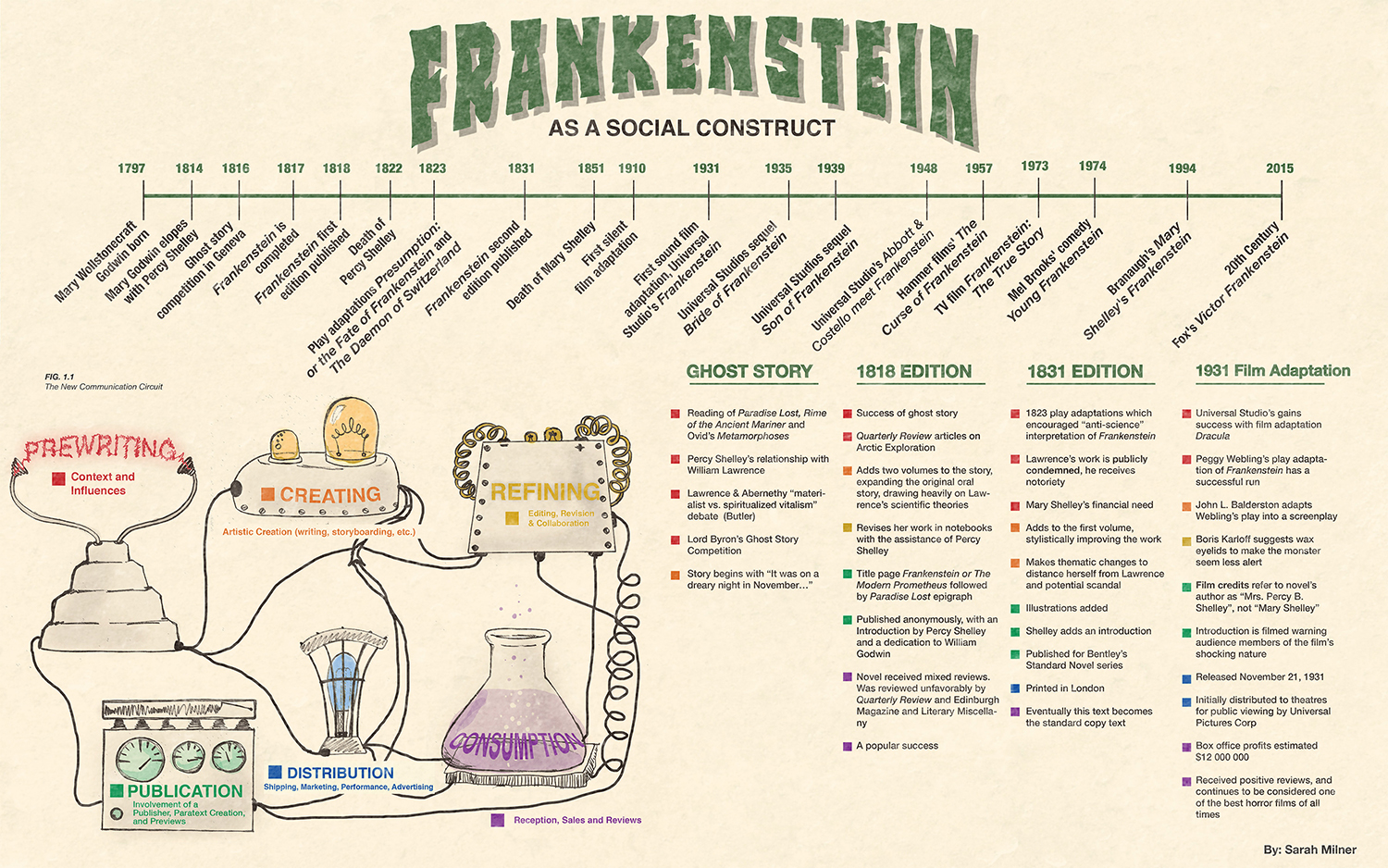Article body
Mary Shelley’s Frankenstein was initially published in 1818. Since then, the story of Frankenstein’s disastrous experiment has become a fixture in popular culture, due largely to the various adaptations that have been made. The first known adaptation of her novel is Richard Brinsley Peake’s Presumption: or the Fate of Frankenstein, which was published before Shelley’s second edition of Frankenstein. Presumption is significant for having introduced the most common divergences from Shelley’s text. Such changes remained popular in following play adaptations of Frankenstein, including Peggy Webling’s twentieth-century version, which was optioned by Universal Studios for their 1931 film. Although these early adaptations contain various elements of the contemporary Frankenstein mythology, certain details, such as the character Igor and the monster’s friendliness towards children, were added by subsequent adaptations.
Frankenstein demonstrates the larger process by which texts develop narratives through a collective understanding of the work, which differs from the original information contained in the initial text. Respected classic novels such as Pride and Prejudice, Oliver Twist, and Dracula have been given contemporary relevancy via play and film adaptations, which have developed the respective stories into cultural icons. The stories and characters have become common knowledge, yet this knowledge is comprised of various remediated texts, many of which creatively diverge from the source material.
This poster illustrates the process through which the story of Frankenstein has developed into a cultural icon, through a reimagining of Robert Darnton’s communication circuit. While Darnton’s diagram is a cycle representing the process of book publishing, my diagram is a stripped-down circuit in which all stages of text production and consumption have the potential to interact and/or influence each other. The top row represents stages in the private sphere, while the bottom row represents the text’s interaction with the public. I have included examples from four versions of Frankenstein to demonstrate how each stage functions, and the potential for each stage to have continued influence on future editions as the story continues to be remediated.
Appendices
Biographical note
Sarah Milner is a graduate student at Trent University, where she is in her second year of the English (Public Texts) M.A. Her thesis, “Frankenstein: the Man, the Monster, and the Myth” examines the evolution of the Frankenstein story, from Mary Shelley’s novel to the contemporary popular culture icon. This research examines the thematic and narrative differences between these remediated texts in order to identify the ways in which Hollywood film impacts Western ideology.
Bibliography
- Adams, Thomas R., and Nicolas Barker. “A New Model for the Study of the Book.” The Book History Reader. Ed. David Finkelstein and Alistair McCleery. New York: Routledge, 2006. 47-65. Print.
- Badalamenti, Anthony F. “Why did Mary Shelley Write Frankenstein?” Journal of Religion and Health 45.3 (Fall 2006): 419-439. JSTOR. Web. 12 Sep. 2014.
- Barthes, Roland. “The Death of the Author.” The Book History Reader. Ed. David Finkelstein and Alistair McCleery. New York: Routledge, 2006. 277-280. Print.
- Darnton, Robert. “What is the History of Books?”. The Book History Reader. Ed. David Finkelstein and Alistair McCleery. New York: Routledge, 2006. 275-276. Print.
- Finkelstein, David, and Alistair McCleery. Editors’ Introduction. The Book History Reader. Ed. David Finkelstein and Alistair McCleery. New York: Routledge, 2006. 275-276. Print.
- Foertsch, Jacqueline. “The Right, the Wrong, and the Ugly: Teaching Shelley’s Several ‘Frankensteins’,” College English 63.6 (Jul. 2001): 697-711. JSTOR. Web. 21 Oct. 2014.
- Foucault, Michel. “What is an Author?” The Book History Reader. Ed. David Finkelstein and Alistair McCleery. New York: Routledge, 2006. 281-291. Print.
- Frankenstein. Dir. James Whale. Perf. Boris Karloff. Universal Studios, 1931. DVD. Universal Studios Home Entertainment, 2014.
- Goldberg, Matt. “First Official Synopses for VICTOR FRANKENSTEIN, GODS OF EGYPT, Universal’s UNTITLED PETS PROJECT & MISS PEREGRINE’S HOME FOR PECULIAR CHILDREN.” Collider. June 2014. Web. December 17, 2014.
- Love, Harold. “Early Modern Print Culture.” The Book History Reader. Ed. David Finkelstein and Alistair McCleery. New York: Routledge, 2006. 74-86. Print.
- Maslin, Janet. “FILM REVIEW: FRANKENSTEIN; A Brain on Ice, a Dead Toad and Voila!” The New York Times. November 4, 1994. Web. December 17, 2014.
- McClintock, Pamela. “Frankenstein Coming to Life for Fox.” The Hollywood Reporter. June 22, 2011. Web. December 17, 2014.
- Shelley, Mary. Frankenstein; or, The Modern Prometheus. Ed. Cynthia Brantley Johnson. New York: Simon & Schuster, 2004. Print.
- Shelley, Mary. Frankenstein: Or the Modern Prometheus – The 1818 Text. Ed. Marilyn Butler. Oxford: Oxford UP, 2009. Print.
- The Shelley-Godwin Archive. The National Endowment for the Humanities and The Gladys Krieble Delmas Foundation. Web. December 17 2014.



